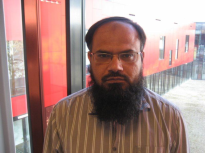Surface Modification of Silicon Nanowire Field-Effect
Devices with Si-C and Si-N bonded Monolayers
Promotion date: 24. November 2011
Promotor: Prof. dr. ir. Albert van den Berg
Assistant promotor: Dr. Edwin. T. Carlen
| The research work mainly focused on surface modification and surface functionalization of active-gate areas of silicon nanowire field-effect transistor devices (Si-NW FET) using hydrogen terminated surfaces, Si-C and Si-N bonded monolayers and subsequent bioimmobilization for biosensor applications.
Experiments were conducted on planar silicon samples for contact angle measurements and x-ray photoelectron spectroscopy (XPS) for the confirmation of step wise surface modification processes. Efficiency of surface modification was tested and monitored by scanning electron microscopy, fluorescence spectroscopy and atomic force microscopy, as well as electric measurements by front and back gating the devices in air and in aqueous solutions. Si-alkyl monolayers proved to be stable and prevent surface oxidation for a reasonable length of time. Si-C bonds can be reasonably detected. Well-packed monolayers terminated with methyl groups are recommended for further bioimmobilization. A mixture of monolayers is also a good approach to obtain functional monolayers. Subsequent bioimmobilization is also confirmed by fluorescence and biosensing studies. Monolayers of Si-NW FET were characterized by electrical measurements and a mathematical model was proposed giving guidelines for improved sensitivity. |
Is your work application oriented?
Yes, early screening of cancer and its cure can be made possible by early detection of biomarkers but need highly sensitive, label-free and real-time biosensors. Silicon nanowire field effect transistors are highly sensitive transducers which can be utilized for this goal. The real challenge apart from its fabrication in the clean room, however, is to functionalize the transducer surface and make it into a biosensor. Using interfaces in nanowires and surface modification are needed.
The greatest problem with silicon based sensors is the fact that there is no more a handsome and easy way just like thiols-based functionalization on gold surfaces. Sometimes silane based functionalization is used but its stability in aqueous solutions lasts only a few hours. This results into response variation of the sensor from time to time.
These monolayers are also not very reproducible due to difficult control over water content and polymerization. It is required to explore other functionalization routes, and one possible solution is Si-C bonded monolayers.
Were there some memorable moments during your thesis work?
My whole thesis work was quite memorable, however I was waiting for good results and the moment I got my first success was quite memorable for me. It was also memorable when I started to think logically and in turn started getting results in the same way. So I learned to think and predict the results before doing experiments.
Where were your findings published?
An article was published in Applied Materials & Interfaces. A poster presentation and proceeding paper were there at Materials Research Society in the US. Also I was a presenter on the European Micromechanics and Microsystems workshop (MME), here in Enschede.
How did you develop personally as a scientist and researcher?
First I was a researcher in my home country, in Pakistan. There I could not work as an independent worker. Also the supervising of the equipment there was very strict.
Here, I got real freedom to perform experiments, build my own ideas and vision of the field. I learned that discussing openly with colleagues and presenting my own findings, is a crucial part of scientific research. Now I feel I am able to do research independently, feeling much more confidence.
What are your future plans?
I am planning to go back to Pakistan and join the research department of chromatography where I used to work. Now I am a much more confident, skilled and educated scientist. I hope I can perform innovative research on new surfaces, usable for sensing in medical applications. I am especially interested in paper-based microfluidics, as is performed at the US labs for example by professor Whiteside. Perhaps cheaper devices are possible for blood testing at larger scales.
What, in your opinion, is important for Mesa+ to stay successful in future?
Cooperation between researchers and people is very important. I like the open knowledge culture at Mesa+. For example the BIOS group, MIS and other groups can share their expertise and combine them more often. That is good for research and eventually for Mesa+

